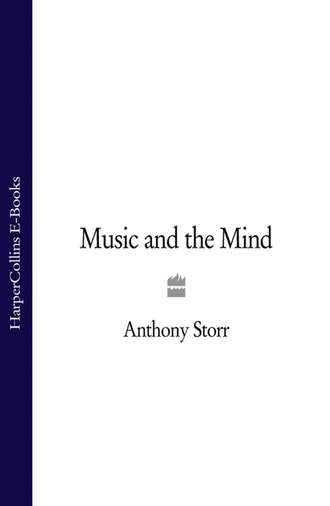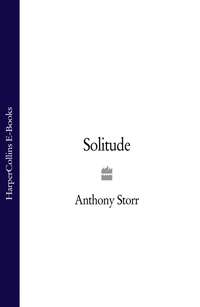
Полная версия
Music and the Mind

ANTHONY STORR


MUSIC AND THE MIND
‘Music’s the Medicine of the Mind’
John Logan (1744–88)


HarperCollins PublishersLtd. 1 London Bridge Street London SE1 9GF
First published in Great Britain by Collins 1992
Copyright © Anthony Storr 1992
The author and publisher gratefully acknowledge permission to reproduce extracts from:
Hitler: The Fuhrer and the People, J.P. Stern (Fontana Press, 1975); Schoenberg, Charles Rosen (Fontana, 1976); The Origins of Consciousness in the Breakdown of the Bicameral Mind, Julian Jaynes, © 1976 Julian Jaynes, reprinted by permission of Houghton Mifflin Co. and Penguin Books Limited.
Anthony Storr asserts the moral right to be identified as the author of this work
A catalogue record for this book is available from the British Library
All rights reserved under International and Pan-American Copyright Conventions. By payment of the required fees, you have been granted the non-exclusive, non-transferable right to access and read the text of this ebook on-screen. No part of this text may be reproduced, transmitted, down-loaded, decompiled, reverse engineered, or stored in or introduced into any information storage and retrieval system, in any form or by any means, whether electronic or mechanical, now known or hereinafter invented, without the express written permission of HarperCollins ebooks
HarperCollinsPublishers has made every reasonable effort to ensure that any picture content and written content in this ebook has been included or removed in accordance with the contractual and technological constraints in operation at the time of publication
Source ISBN: 9780006861867
Ebook Edition © JANUARY 2017 ISBN: 9780007383993
Version: 2017-02-08
FOR
SOPHIA, POLLY, AND EMMA
WHO SHARE MY LOVE
OF MUSIC
Contents
Cover
Title Page
Copyright
INTRODUCTION
CHAPTER I ORIGINS AND COLLECTIVE FUNCTIONS
CHAPTER II MUSIC, BRAIN AND BODY
CHAPTER III BASIC PATTERNS
CHAPTER IV SONGS WITHOUT WORDS
CHAPTER V ESCAPE FROM REALITY?
CHAPTER VI THE SOLITARY LISTENER
CHAPTER VII THE INNERMOST NATURE OF THE WORLD
CHAPTER VIII A JUSTIFICATION OF EXISTENCE
CHAPTER IX THE SIGNIFICANCE OF MUSIC
Keep Reading
References
Bibliography
Index
Acknowledgements
About the Author
By the Same Author
About the Publisher
Introduction
Since music is the only language with the contradictory attributes of being at once intelligible and untranslatable, the musical creator is a being comparable to the gods, and music itself the supreme mystery of the science of man.
CLAUDE LÉVI-STRAUSS1
Today, more people listen to music than ever before in the history of the world. The audience has increased enormously since the Second World War. Recordings, radio, and even television, have made music available to a wider range of the population than anyone could have predicted fifty years ago. In spite of dire warnings that recordings might empty opera houses and concert halls, the audience for live performances has also multiplied.
This book reflects my personal preference in that it is primarily concerned with classical or Western ‘art’ music, rather than with ‘popular’ music. That these two varieties of music should have become so divergent is regrettable. The demand for accessible musical entertainment grew during the latter half of the nineteenth century in response to the increased wealth of the middle class. It was met by Offenbach, both Johann Strausses, Chabrier, Sullivan, and other gifted composers of light music which still enchants us today. The tradition was carried on into the twentieth century by composers of the stature of Gershwin, Jerome Kern, and Irving Berlin. It is only since the 1950s that the gap between classical and popular music has widened into a canyon which is nearly unbridgeable.
In spite of its widespread diffusion, music remains an enigma. Music for those who love it is so important that to be deprived of it would constitute a cruel and unusual punishment. Moreover, the perception of music as a central part of life is not confined to professionals or even to gifted amateurs. It is true that those who have studied the techniques of musical composition can more thoroughly appreciate the structure of a musical work than those who have not. It is also true that people who can play an instrument, or who can sing, can actively participate in music in ways which enrich their understanding of it. Playing in a string quartet, or even singing as one anonymous voice in a large choir, are both life-enhancing activities which those who take part in them find irreplaceable. But even listeners who cannot read musical notation and who have never attempted to learn an instrument may be so deeply affected that, for them, any day which passes without being seriously involved with music in one way or another is a day wasted.
In the context of contemporary Western culture, this is puzzling. Many people assume that the arts are luxuries rather than necessities, and that words or pictures are the only means by which influence can be exerted on the human mind. Those who do not appreciate music think that it has no significance other than providing ephemeral pleasure. They consider it a gloss upon the surface of life; a harmless indulgence rather than a necessity. This, no doubt, is why our present politicians seldom accord music a prominent place in their plans for education. Today, when education is becoming increasingly utilitarian, directed toward obtaining gainful employment rather than toward enriching personal experience, music is likely to be treated as an ‘extra’ in the school curriculum which only affluent parents can afford, and which need not be provided for pupils who are not obviously ‘musical’ by nature. The idea that music is so powerful that it can actually affect both individuals and the state for good or ill has disappeared. In a culture dominated by the visual and the verbal, the significance of music is perplexing, and is therefore underestimated. Both musicians and lovers of music who are not professionally trained know that great music brings us more than sensuous pleasure, although sensuous pleasure is certainly part of musical experience. Yet what it brings is hard to define. This book is an exploratory search; an attempt to discover what it is about music that so profoundly affects us, and why it is such an important part of our culture.
CHAPTER I ORIGINS AND COLLECTIVE FUNCTIONS
Music is so naturally united with us that we cannot be free from it even if we so desired.
BOETHIUS1
No culture so far discovered lacks music. Making music appears to be one of the fundamental activities of mankind; as characteristically human as drawing and painting. The survival of Palaeolithic cave-paintings bears witness to the antiquity of this form of art; and some of these paintings depict people dancing. Flutes made of bone found in these caves suggest that they danced to some form of music. But, because music itself only survives when the invention of a system of notation has made a written record possible, or else when a living member of a culture recreates the sounds and rhythms which have been handed down to him by his forebears, we have no information about prehistoric music. We are therefore accustomed to regarding drawing and painting as integral parts of the life of early man, but less inclined to think of music in the same way. However, music, or musical sounds of some variety, are so interwoven with human life that they probably played a greater part in prehistory than can ever be determined.
When biologists consider complex human activities such as the arts, they tend to assume that their compelling qualities are derivations of basic drives. If any given activity can be seen to aid survival or facilitate adaptation to the environment, or to be derived from behaviour which does so, it ‘makes sense’ in biological terms. For example, the art of painting may originate from the human need to comprehend the external world through vision; an achievement which makes it possible to act upon the environment or influence it in ways which promote survival. The Palaeolithic artists who drew and painted animals on the walls of their caves were using their artistic skills for practical reasons. Drawing is a form of abstraction which may be compared with the formation of verbal concepts. It enables the draughtsman to study an object in its absence; to experiment with various images of it, and thus, at least in phantasy, to exert power over it. These artists were magicians, who painted and drew animals in order to exercise magical charms upon them. By capturing the image of the animal, early humans probably felt that they could partially control it. Since the act of drawing sharpens the perceptions of the artist by making him pay detailed attention to the forms he is trying to depict, the Palaeolithic painter did in reality learn to know his prey more accurately, and therefore increased his chances of being successful in the hunt. The art historian Herbert Read wrote:
Far from being an expenditure of surplus energy, as earlier theories have supposed, art, at the dawn of human culture, was a key to survival, a sharpening of the faculties essential to the struggle for existence. Art, in my opinion, has remained a key to survival.2
The art of literature probably derived from that of the primitive story-teller. He was not merely providing entertainment, but passing down to his listeners a tradition of who they were, where they had come from, and what their lives signified. By making sense and order out of his listeners’ existence, he was enhancing their feeling of personal worth in the scheme of things and therefore increasing their capacity to deal effectively with the social tasks and relationships which made up their lives. The myths of a society usually embody its traditional values and moral norms. Repetition of these myths therefore reinforces the coherence and unity of the society, as well as giving each individual a sense of meaning and purpose. Both painting and literature can be understood as having developed from activities which, originally, were adaptively useful.
But what use is music? Music can certainly be regarded as a form of communication between people; but what it communicates is not obvious. Music is not usually representational: it does not sharpen our perception of the external world, nor, allowing for some notable exceptions,*does it generally imitate it. Nor is music propositional: it does not put forward theories about the world or convey information in the same way as does language.
There are two conventional ways in which one can approach the problem of the significance of music in human life. One is to examine its origins. Music today is highly developed, complex, various and sophisticated. If we could understand how it began, perhaps we could better understand its fundamental meaning. The second way is to examine how music has actually been used. What functions has music served in different societies throughout history?
There is no general agreement about the origins of music. Music has only tenuous links with the world of nature. Nature is full of sound, and some of nature’s sounds, such as running water, may give us considerable pleasure. A survey of sound preferences amongst people in New Zealand, Canada, Jamaica and Switzerland revealed that none disliked the sounds of brooks, rivers and waterfalls, and that a high proportion enjoyed them.3 But nature’s sounds, with the exception of bird-song and some other calls between animals, are irregular noises rather than the sustained notes of definable pitch which go to form music. This is why the sounds of which Western music is composed are referred to as ‘tones’: they are separable units with constant auditory waveforms which can be repeated and reproduced.
Although science can define the differences between tones in terms of pitch, loudness, timbre, and waveform, it cannot portray the relation between tones which constitutes music. Whilst there is still considerable dispute concerning the origins, purpose, and significance of music, there is general agreement that it is only remotely related to the sounds and rhythms of the natural world. Absence of external association makes music unique amongst the arts; but since music is closely linked with human emotions, it cannot be regarded as no more than a disembodied system of relationships between sounds. Music has often been compared with mathematics; but, as G. H. Hardy pointed out, ‘Music can be used to stimulate mass emotion, while mathematics cannot.’4
If music were merely a series of artificial constructs comparable with decorative visual patterns, it would induce a mild aesthetic pleasure, but nothing more. Yet music can penetrate the core of our physical being. It can make us weep, or give us intense pleasure. Music, like being in love, can temporarily transform our whole existence. But the links between the art of music and the reality of human emotions are difficult to define; so difficult that, as we shall see, many distinguished musicians have abandoned any attempt to do so, and have tried to persuade us that musical works consist of disembodied patterns of sound which have no connection with other forms of human experience.
Can music be related to the sounds made by other species? The most obviously ‘musical’ of such sounds are those found in bird-song. Birds employ both noises and tones in their singing; but the proportion of definable tones is often high enough for some people to rate some bird-songs as ‘music’. Bird-song has a number of different functions. By locating the singer, it both advertises a territory as desirable, and also acts as a warning to rivals. Birds in search of a mate sing more vigorously than those who are already mated, thus supporting Darwin’s notion that song was originally a sexual invitation. Bird-song is predominantly a male activity, dependent upon the production of the male sex hormone, testosterone, although duets between male and female occur in some species. Given sufficient testosterone, female birds who do not usually sing will master the same repertoire of songs as the male.5
Charles Hartshorne, the American ornithologist and philosopher, claims that bird-song shows variation of both pitch and tempo: accelerando, crescendo, diminuendo, change of key, and variations on a theme. Some birds, like the Wood thrush Hylochicla mustelina, have a repertoire of as many as nine songs which can follow each other in a variety of different combinations. Hartshorne argues:
Bird songs resemble human music both in the sound patterns and in the behavior setting. Songs illustrate the aesthetic mean between chaotic irregularity and monotonous regularity … The essential difference from human music is in the brief temporal span of the bird’s repeatable patterns, commonly three seconds or less, with an upper limit of about fifteen seconds. This limitation conforms to the concept of primitive musicality. Every simple musical device, even transposition and simultaneous harmony, occurs in bird music.6
He goes on to state that birds sing far more than is biologically necessary for the various forms of communication. He suggests that bird-song has partially escaped from practical usage to become an activity which is engaged in for its own sake: an expression of avian joie de vivre.
Singing repels rival males, but only when nearby; and it attracts mates. It is persisted in without any obvious immediate result, and hence must be largely self-rewarding. It expresses no one limited emotional attitude and conveys more information than mere chirps or squeaks. In all these ways song functions like music.7
Other observers disagree, claiming that bird-song is so biologically demanding that it is unlikely to be produced unless it is serving some useful function.
Is it possible that human music originated from the imitation of bird-song? Géza Révész, who was a professor of Psychology at the University of Amsterdam and a friend of Béla Bartók, dismisses this possibility on two counts. First, if human music really began in this way, we should be able to point to examples of music resembling bird-song in isolated pre-literate communities. Instead, we find complex rhythmic patterns bearing no resemblance to avian music. Second, bird-song is not easily imitated. Slowing down modern recordings of bird-songs has demonstrated that they are even more complicated than previously supposed; but one only has to listen to a thrush singing in the garden to realize that imitation of his song is technically difficult. Liszt’s ‘Légende’ for solo piano, ‘St François d’Assise: La Prédication aux oiseaux’, manages to suggest the twittering of birds in ways which are both ingenious and musically convincing. I have heard a tape of American bird-song which persuasively suggests that Dvořák incorporated themes derived from it following his sojourn in the Czech community in Spillville, Iowa. Olivier Messiaen made more use of bird-song in his music than any other composer. But these are sophisticated, late developments in the history of music. It is probable that early man took very little notice of bird-song, since it bore scant relevance to his immediate concerns.8
Lévi-Strauss affirms that music is in a special category compared with the other arts, and also agrees that bird-song cannot be the origin of human music.
If, through lack of verisimilitude, we dismiss the whistling of the wind through the reeds of the Nile, which is referred to by Diodorus, we are left with little but bird song – Lucretius’ liquidas avium voces – that can serve as a natural model for music. Although ornithologists and acousticians agree about the musicality of the sounds uttered by birds, the gratuitous and unverifiable hypothesis of the existence of a genetic relation between bird song and music is hardly worth discussing.9
Stravinsky points out that natural sounds, like the murmur of the breeze in the trees, the rippling of a brook or the song of a bird, suggest music to us but are not themselves music: ‘I conclude that tonal elements become music only by virtue of their being organized, and that such organization presupposes a conscious human act.’10
It is not surprising that Stravinsky emphasizes organization as the leading feature of music, since he himself was one of the most meticulous, orderly, and obsessionally neat composers in the history of music. But his emphatic statement is surely right. Bird-song has some elements of music in it, but, although variations upon inherited patterns occur, it is too obviously dependent upon in-built templates to be compared with human music.
In general, music bears so little resemblance to the sounds made by other species that some scholars regard it as an entirely separate phenomenon. This is the view of the ethnomusicologist John Blacking, who was, until his untimely death, Professor of Social Anthropology at the Queen’s University of Belfast, as well as being an accomplished musician.
There is so much music in the world that it is reasonable to suppose that music, like language and possibly religion, is a species-specific trait of man. Essential physiological and cognitive processes that generate musical composition and performance may even be genetically inherited, and therefore present in almost every human being.11
If music is indeed species-specific, there might seem to be little point in comparing it with the sounds made by other species. But those who have studied the sounds made by subhuman primates, and who have discovered what functions these sounds serve, find interesting parallels with human music. Gelada monkeys produce a wide variety of sounds of different pitches which accompany all their social interactions. They also use many different rhythms, accents, and types of vocalization. The particular type of sound which an individual produces indicates his emotional state at the time and, in the longer term, aids the development of stable bonds between different individuals. When tensions between individuals exist, these can sometimes be resolved by synchronizing and coordinating vocal expressions.
Human beings, like geladas, also use rhythm and melody to resolve emotional conflicts. This is perhaps the main social function served by group singing in people … Music is the ‘language’ of emotional and physiological arousal. A culturally agreed-upon pattern of rhythm and melody, i.e., a song, that is sung together, provides a shared form of emotion that, at least during the course of the song, carries along the participants so that they experience their bodies responding emotionally in very similar ways. This is the source of the feeling of solidarity and good will that comes with choral singing: people’s physiological arousals are in synchrony and in harmony, at least for a brief period. It seems possible that during the course of human evolution the use of rhythm and melody for the purposes of speaking sentences grew directly out of its use in choral singing. It also seems likely that geladas singing their sound sequences together synchronously and harmoniously also perhaps experience such a temporary physiological synchrony.12
We shall return to the subject of group arousal in the next chapter. Meanwhile, let us consider some other speculations about the origin of music.
One theory is that music developed from the lalling of infants. All infants babble, even if they are born deaf or blind. During the first year of life, babbling includes tones as well as approximations to words: the precursors of music and language cannot be separated. According to the Harvard psychologist Howard Gardner, who has conducted research into the musical development of small children:
The first melodic fragments produced by children around the age of a year or fifteen months have no strong musical identity. Their undulating patterns, going up and down over a very brief interval or ambitus, are more reminiscent of waves than of particular pitch attacks. Indeed, a quantum leap, in an almost literal sense, occurs at about the age of a year and a half, when for the first time children can intentionally produce discrete pitches. It is as if diffuse babbling had been supplanted by stressed words.13
During the next year, children make habitual use of discrete pitches, chiefly using seconds, minor thirds, and major thirds. By the age of two or two and a half, children are beginning to notice and learn songs sung by others. Révész is quite sure that the lalling melodies produced by children in their second year are already conditioned by songs which they have picked up from the environment or by other music to which they have been exposed.14 If lalling melodies are in fact dependent upon musical input from the environment, it is obviously inadmissible to suggest that music itself developed from infant lalling.
Ellen Dissanayake, who teaches at the New School for Social Research in New York and who has lived in Sri Lanka, Nigeria, and Papua New Guinea, persuasively argues that music originated in the ritualized verbal exchanges which go on between mothers and babies during the first year of life. In this type of interchange, the most important components of language are those which are concerned with emotional expressiveness rather than with conveying factual information. Metre, rhythm, pitch, volume, lengthening of vowel sounds, tone of voice, and other variables are all characteristic of a type of utterance which has much in common with poetry. She writes:





